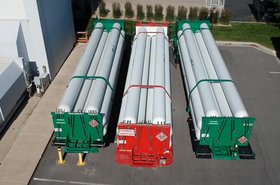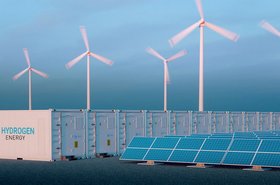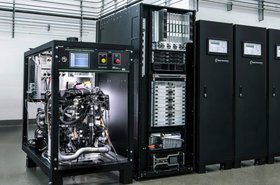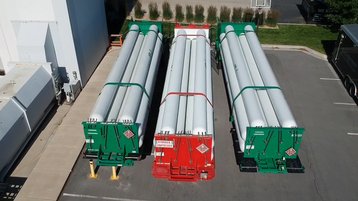The development of hydrogen fuel-cell technology as an alternative to diesel backup will enable data center operators to completely “rework” their electrical systems, according to Mark Monroe, the principal engineer at Microsoft’s Datacenter Advanced Development Group and winner of the Energy Smart Award at the DCD>Global Awards.
In particular, Monroe believes, hydrogen fuel-cells could render the UPS redundant, as well as diesel backup generators. However, it could be another decade – or more – before second generation hydrogen fuel-cell technology is able to rise to the challenge.
“If you start out with just a diesel generator replacement [program] you end up immediately looking at some of the elements of the system and say, ‘Why are we duplicating this function or that function? Why don’t we have a different kind of power available? How can we use that in a more efficient way?’” said Monroe, speaking at DCD’s recent Towards Net-Zero event, where he was presenting Microsoft’s research into the use of hydrogen fuel-cells.
Time for a rethink
Microsoft’s research into hydrogen fuel cells and other ‘alternative’ forms of power for data centers comes as the company has promised to not just be carbon-neutral by 2030, but carbon negative. This commitment is also supported by co-founder Bill Gates, who has kept a close eye on Monroe’s research.
In the recent experiments conducted by Monroe and his team, the aim was purely to see whether hydrogen fuel-cells could be used for back-up. “Our goal was to scare our engineering group as little as possible by saying that this is just a drop-in diesel generator replacement, so we don’t have to change any of the electrical design.
Tune in to these sessions on critical power
“But the real opportunity, in my opinion, is when we start getting into generation two of this and say, well, ‘What would we do differently with the electrical system in a hyperscale data center if we had reliable direct current non-polluting power available at the drop of a hat?’
“I think you’d want to start looking at different architectures and, maybe, changing the whole way the electrical system works; [examining] how it might be reworked.”
Monroe was responding to questions from the audience after presenting details of the company’s research into hydrogen fuel-cell technology so far, which started with a type of fuel cell called proton-exchange membrane (PEM) as an alternative to diesel backup.
“Diesel generators are an absolute necessity for us to be able to have five-nines of availability at data centers, and a lot of data centers keep 24-to-48 hours of fuel on-site… But no-one in the industry really likes diesel generators because they are noisy, they pollute and they produce, not just carbon, but also particulates, including nitrous oxides. And they’re getting more and more difficult to permit at the levels that some hyperscale companies are moving,” said Monroe.
Moreover, with the advent of the hyperscale data center, the level of diesel generator backup also needs to be scaled up accordingly. “If we go to an authority and say, ‘We’re going to need 200MW of diesel backup’, they start to add that up and think, ‘We can’t allow that. That’s too much load on our air quality permits.' And if we can’t get the permits we can’t grow to meet demand.”
Alternative energy
The idea started around two years ago with an automotive fuel-cell developed with HPE and the Daimler car company. The aim of that experiment was merely to power a rack of servers with a 65kW fuel cell as a proof-of-concept.
That experiment ran in what Monroe described as a “bottomless UPS," with the fuel-cell piping in DC current to the UPS, which powered the rack. While that demo worked, the next step was to see whether it might scale, not just in terms of power output, but also durability – Daimler’s fuel-cells had been designed to run for four-to-six hours before stopping for refuelling.
In particular, Monroe’s team needed to find out whether there might be, for example, overheating issues with running on hydrogen fuel-cells for an extended period of time.
That experiment involved a series of hydrogen storage trucks feeding the fuel cells for 48 hours, non-stop. “The only output from the fuel cells is warm water vapor after the hydrogen and oxygen combine,” said Monroe. Fortunately, the generated steam is not scalding hot. “It cooled down very quickly as it came out and it was very quiet compared to a diesel generator.”
However, there are currently a number of drawbacks to hydrogen fuel-cell technology, which means that it is by no means a 'slam dunk' that it will replace diesel backup.
One of the key ones is the fact that the safe transport and storage of hydrogen requires it to be liquefied. This means that the volatile gas needs to be cooled-down to 20 degrees Kelvin, around -250 degrees celsius or in excess of -420 degrees Fahrenheit. Storing it long-term might also present a challenge because, as Monroe admits, some will vaporize every day. And for fuel cells to provide three megawatts of power for 48 hours also requires a considerable amount of it: about 18,000 US gallons.
Nevertheless, it is still early days for hydrogen fuel-cell technology and Monroe is looking forward to conducting a 3MW test later this year. It is not the only alternative to diesel backup generation that Microsoft is researching: “We are certainly are looking at other fuels… I expect in that 2030 timeframe there will be a number of different solutions, including other liquid fuels,” said Monroe.
For more, register for DCD>Grid Scale, the global virtual summit on energy system integration for data centers.
Further reading
-

Could hydrogen kill off diesel?
Microsoft ran 10 racks on a hydrogen fuel cell for 48 hours. Here’s what comes next
-

Atos and HDF Energy plan hydrogen-powered data center for 2023
A testbed as the companies look to launch hydrogen products for the data center industry
-

Daimler and HPE research hydrogen fuel cells for data centers
First systems to be developed this year


